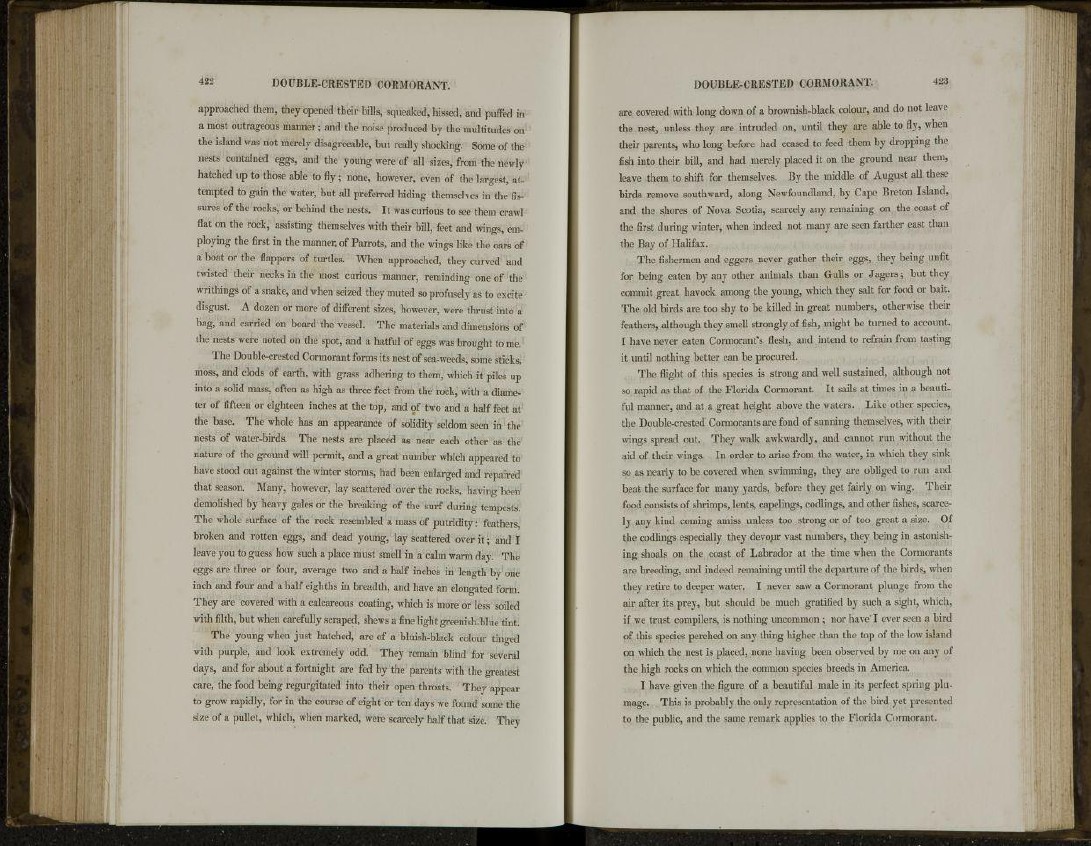
approached them, they opened their bills, squeaked, hissed, and puffed in
a most outrageous manner; and the noise produced by the multitudes on
the island was not merely disagreeable, but really shocking. Some of the
nests contained eggs, and the young were of all sizes, from the newly
hatched up to those able to fly ; none, however, even of the largest, attempted
to gain the water, but all preferred hiding themselves in the fissures
of the rocks, or behind the nests. It was curious to see them crawl
flat on the rock, assisting themselves with their bill, feet and wings, employing
the first in the manner, of Parrots, and the wings like the oars of
a boat or the flappers of turtles. When approached, they curved and
twisted their necks in the most curious manner, reminding one of the
writhings of a snake, and when seized they muted so profusely as to excite
disgust. A dozen or more of different sizes, however, were thrust into a
bag, and carried on board the vessel. The materials and dimensions of
the nests were noted on the spot, and a hatful of eggs was brought to me.
The Double-crested Cormorant forms its nest of sea-weeds, some sticks,
moss, and clods of earth, with grass adhering to them, which it piles up
into a solid mass, often as high as three feet from the rock, with a diameter
of fifteen or eighteen inches at the top, and of two and a half feet at
the base. The whole has an appearance of solidity seldom seen in the
nests of water-birds. The nests are placed as near each other as the
nature of the ground will permit, and a great number which appeared to
have stood out against the winter storms, had been enlarged and repaired
that season. Many, however, lay scattered over the rocks, having been
demolished by heavy gales or the breaking of the surf during tempests.
The whole surface of the rock resembled a mass of putridity: feathers,
broken and rotten eggs, and dead young, lay scattered over it; and I
leave you to guess how such a place must smell in a calm warm day. The
eggs are three or four, average two and a half inches in length by one
inch and four and a half eighths in breadth, and have an elongated form.
They are covered with a calcareous coating, which is more or less soiled
with filth, but when carefully scraped, shews a fine light greenish-blue tint.
The young when just hatched, are of a bluish-black colour tinged
with purple, and look extremely odd. They remain blind for several
days, and for about a fortnight are fed by the parents with the greatest
care, the food being regurgitated into their open throats. They appear
to grow rapidly, for in the course of eight or ten days we found some the
size of a pullet, which, when marked, were scarcely half that size. They
are covered with long down of a brownish-black colour, and do not leave
the nest, unless they are intruded on, until they are able to fly, when
their parents, who long before had ceased to feed them by dropping the
fish into their bill, and had merely placed it on the ground near them,
leave them to shift for themselves. By the middle of August all these
birds remove southward, along Newfoundland, by Cape Breton Island,
and the shores of Nova Scotia, scarcely any remaining on the coast of
the first during winter, when indeed not many are seen farther east than
the Bay of Halifax.
The fishermen and eggers never gather their eggs, they being unfit
for being eaten by any other animals than Gulls or Jagers; but they
commit great havock among the young, which they salt for food or bait.
The old birds are too shy to be killed in great numbers, otherwise their
feathers, although they smell strongly of fish, might be turned to account.
I have never eaten Cormorant's flesh, and intend to refrain from tasting
it until nothing better can be procured.
The flight of this species is strong and well sustained, although not
so rapid as that of the Florida Cormorant. It sails at times in a beautiful
manner, and at a great height above the waters. Like other species,
the Double-crested Cormorants are fond of sunning themselves, with their
wings spread out. They walk awkwardly, and cannot run without the
aid of their wings. In order to arise from the water, in which they sink
so as nearly to be covered when swimming, they are obliged to run and
beat the surface for many yards, before they get fairly on wing. Their
food consists of shrimps, lents, capelings, codlings, and other fishes, scarcely
any kind coming amiss unless too strong or of too great a size. Of
the codlings especially they devo.ur vast numbers, they being in astonishing
shoals on the coast of Labrador at the time when the Cormorants
are breeding, and indeed remaining until the departure of the birds, when
they retire to deeper water. I never saw a Cormorant plunge from the
air after its prey, but should be much gratified by such a sight, which,
if we trust compilers, is nothing uncommon ; nor have' I ever seen a bird
of this species perched on any thing higher than the top of the low island
on which the nest is placed, none having been observed by me on any of
the high rocks on which the common species breeds in America.
I have given the figure of a beautiful male in its perfect spring plumage.
This is probably the only representation of the bird yet presented
to the public, and the same remark applies to the Florida Cormorant.